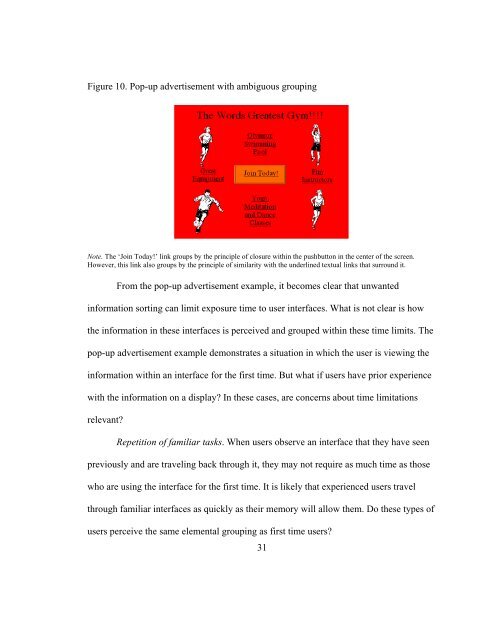The Use of Iambic Pentameter in the
The Use of Iambic Pentameter in the
The Use of Iambic Pentameter in the
You also want an ePaper? Increase the reach of your titles
YUMPU automatically turns print PDFs into web optimized ePapers that Google loves.
Figure 10. Pop-up advertisement with ambiguous group<strong>in</strong>g<br />
Note. <strong>The</strong> ‘Jo<strong>in</strong> Today!’ l<strong>in</strong>k groups by <strong>the</strong> pr<strong>in</strong>ciple <strong>of</strong> closure with<strong>in</strong> <strong>the</strong> pushbutton <strong>in</strong> <strong>the</strong> center <strong>of</strong> <strong>the</strong> screen.<br />
However, this l<strong>in</strong>k also groups by <strong>the</strong> pr<strong>in</strong>ciple <strong>of</strong> similarity with <strong>the</strong> underl<strong>in</strong>ed textual l<strong>in</strong>ks that surround it.<br />
From <strong>the</strong> pop-up advertisement example, it becomes clear that unwanted<br />
<strong>in</strong>formation sort<strong>in</strong>g can limit exposure time to user <strong>in</strong>terfaces. What is not clear is how<br />
<strong>the</strong> <strong>in</strong>formation <strong>in</strong> <strong>the</strong>se <strong>in</strong>terfaces is perceived and grouped with<strong>in</strong> <strong>the</strong>se time limits. <strong>The</strong><br />
pop-up advertisement example demonstrates a situation <strong>in</strong> which <strong>the</strong> user is view<strong>in</strong>g <strong>the</strong><br />
<strong>in</strong>formation with<strong>in</strong> an <strong>in</strong>terface for <strong>the</strong> first time. But what if users have prior experience<br />
with <strong>the</strong> <strong>in</strong>formation on a display? In <strong>the</strong>se cases, are concerns about time limitations<br />
relevant?<br />
Repetition <strong>of</strong> familiar tasks. When users observe an <strong>in</strong>terface that <strong>the</strong>y have seen<br />
previously and are travel<strong>in</strong>g back through it, <strong>the</strong>y may not require as much time as those<br />
who are us<strong>in</strong>g <strong>the</strong> <strong>in</strong>terface for <strong>the</strong> first time. It is likely that experienced users travel<br />
through familiar <strong>in</strong>terfaces as quickly as <strong>the</strong>ir memory will allow <strong>the</strong>m. Do <strong>the</strong>se types <strong>of</strong><br />
users perceive <strong>the</strong> same elemental group<strong>in</strong>g as first time users?<br />
31

















